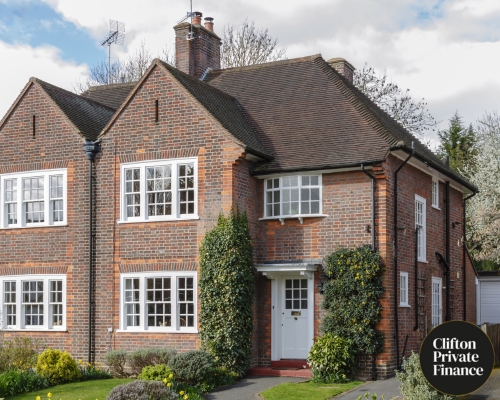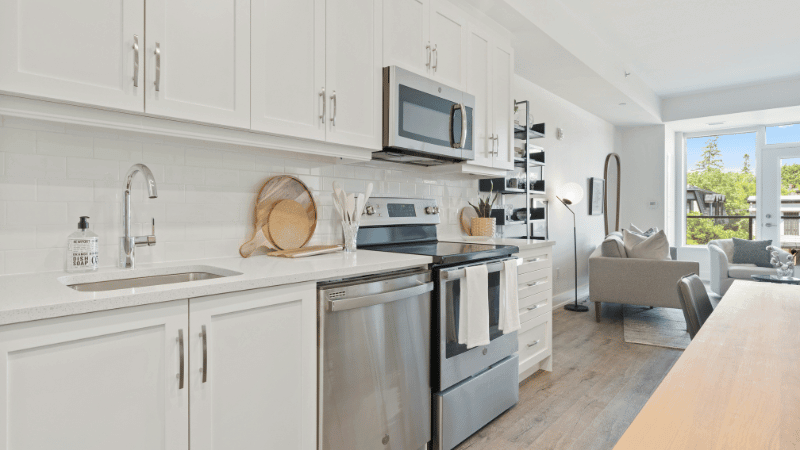Categories
Sell and Upsize Your Home or Renovate - Your Finance Options

The impact of 2020 has been felt by all British citizens: Covid-19 has affected every facet of our daily lives.
Lockdown confined us all to our homes for six months of living, working and being inside the same four walls day after day after day.
And with a second lockdown a possibility, it has left a large amount of British homeowners have one thing on their mind: the need for more space.
People’s priorities have changed: the sharp, sudden increase of working from home has lead homeowners to pining for more room so they can separate their work and living spaces – not to mention that the requirement to live close to their work to ensure a short commute as plummeted in popularity.
The need for outside space has also increased – gardens have moved from the ‘nice to have’ category to the ‘absolutely essential’ category.
There are two main ways you can achieve this:
- Add more living space to your existing home by renovating (e.g. an extension or renovating your garage into an office)
- Or sell your home and upsize to a bigger property

Renovate and Re-imagine Your Current Home
This is all about that all-important phrase: “adding value”.
By renovating your home, you can both add space to give you more breathing room should a second lockdown occur and add value to your home, so if you ever decide to sell it on, you will hopefully get able to list your home for a higher price.
When it comes to financing the work you’d like done to your home, the options you have are…
- Bridging Finance
- Renovation Mortgage
- Refurbishment Mortgage

What is a Renovation Mortgage?
Technically speaking, funding which is secured for improvement works is technically a renovation loan – rather than a renovation mortgage.
What makes this type of loan different is the time scale: a mortgage is typically arranged over a time span of 20-25 years plus, whereas this is a short-term form of borrowing.
This is a useful difference when it comes to renovation as it should (ideally) result in a higher LTV ratio by increasing the value of your home. This will open doors to cheaper borrowing once the work is completed - without paying the early repayment penalty charges which standard mortgage finance would incur.
If you’re interested in a renovation mortgage, the best thing you can do is call one of our experienced brokers – they’ll be able to use their expert knowledge to judge whether or not this is the right kind of borrowing for you, and secure you your funding. But if you’re looking to get a preliminary idea of what you could borrow, use our renovation mortgage calculator.

What is a Refurbishment Mortgage?
Like a renovation mortgage, the title of this is a slight misnomer; you’ll actually need more of a refurbishment loan. This would be a more short term form of borrowing.
Getting in touch with a mortgage broker and explaining the scale of work you need done is the best way to get an understanding of the type (and amount) of funding you will need. But there are different kinds of refurbishment mortgages, so it’s important to know what you’re looking for:
- A light redevelopment/refurbishment loan: These are for non-structural, largely aesthetic work to a house – emphatically, these do not require planning permission and do not need to comply with building regulations (such as upgrading bathrooms and kitchens and replacing floor-coverings).
- A heavy refurbishment loan: These loans are for projects where the total cumulative cost of the work will come to more than 15% of the property value – and also involves structural changes, such as altering internal supporting walls or building an extension. For fairly extensive work (i.e. work that will necessitate time for securing planning permission and will take longer than 12 months) will need a longer loan term, so make sure to let your broker know this.
- A Flexible draw down: This kind of development finance can be made available for major projects; it essentially allows you to draw down funds as and when you need them – this way, you only pay interest on the funding you have accessed.
Read blog: How to Secure a Mortgage for a Property Without a Kitchen

What is Bridging Finance?
Bridging is a specific form of short-term borrowing that can be an excellent funding solution for the right borrower.
If you have enough equity in the home you currently own, then a bridging loan can be an excellent option to secure short term finance, which can then a paid off via a remortgage. The clue is somewhat in the name - bridging is designed to ‘bridge the gap’ before you can secure more long term finance solutions.
There are some important things you need to know about bridging finance should you decide to consider this form of funding:
- It’s short term borrowing – these are available generally for a maximum of 12 months, if you’re borrowing against your own home. If you are borrowing against an investment property, then the terms can be up to 18 months, and maybe longer depending on the situation.
- You need to have an established ‘exit’ strategy which is agreed with your lender before you secure the borrowing.
- You have the choice between a ‘closed’ or an ‘open’ bridge.
- A closed bridge is a bridging loan where the exit date is established.
- An open bridge is where an exit strategy has been agreed but the exact date is more flexible and depends on external factors (e.g. completion of works).
Mortgaging to Upsize
This is a more standard form of mortgaging in that what you will need to upsize is just that: a standard mortgage. From your first homebuying experience, you’ll be familiar with the hoops you need to jump through, but it’s important to factor in the impact of the pandemic to securing a mortgage at the moment. Lenders are a bit more cautious in these ‘unprecedented times’ – so the bigger your deposit, the more likely you are to secure a good mortgage.
The amount you can buy will depend on the usual factors: your budget, your equity in your current home, your affordability etc. Read more about our mortgage service here.
.jpg)
So, with that in mind, when looking to upsize we suggest you consider the following…
- Do you want to change location?
- When do you want to move?
- How much equity do you have in your current home?
Do you want to change location?
Lots of people will be looking further afield than cities as a result of lockdown. Previously your priorities might have been proximity to a workplace – but with the rise of working from home, this might not necessarily be key anymore.
Write down a list of “must haves” as well as “desirables” before you begin looking.
It’s important to remember you’re not the only person thinking along these lines, so be prepared for competition in the buying market.
When do you want to move?
Chains are the scourge of the house-buying process; they can add months onto the process. Considering how busy the market has been in the past few months, you may end up in a chain that moves quickly, or you might be in a chain that moves at a snail’s pace. If a quick turn around is important to you, you could consider alternative funding such as bridging, as this can help.
It’s also important not to leave it too late to secure your funding – the stamp duty holiday will only last until March 31st.
How much equity do you have in your current home?
It is usually the case that the more equity you have in your home, the better – but right now, it is even more of an advantage when house hunting to have more equity in your current home. As stated before, the financial fluctuations of the past seven months has resulted in lenders being a bit more cautious. So the bigger your deposit, the more likely you are to secure the funding you want.

Bridging to Upsize
Bridging can be a useful when seeking funding to upsize – for the right borrower in the right situation.
If you have managed to build up quite a lot of equity in your current home, then a bridging loan can be used to repay your mortgage and give you additional funds to purchase your future home – essentially giving you the same position as a cash buyer.
You can then purchase your new home with the money from the bridging loan, and your exit strategy could either be the sale of your current home, a mortgage on your next one or a combination of the two.
The main advantage this gives you is that this can help you to beat the competition by securing being the best candidate to the seller; and you then can pay off the bridging loan with a mortgage which you can secure later.
Bridging loans can generally be divided into two categories: regulated and unregulated. A regulated bridging loan applies to a loan for a property in which you intend to live. An unregulated bridging loan applies only to an investment property, so you won’t need to worry about that when buying your new home.
Read how we’ve helped other clients secure their ideal finance:
- Bridging Loan to Do Up, Sell and Downsize
- Bridging Finance to Secure a His and Hers Property in Uxbridge
- Bridging Loan to Secure Dream Home in Cornwall
- Short Term Lending for Major Renovations on Dream London Home
Our team of expert brokers specialise in securing both the right mortgage and bridging funding for you depending on your situation. By speaking to one of our team, and explaining your circumstances, we can see how we can help you secure the right funding.
Call us now
0117 959 5094
And if you’ve found this blog useful, please pass it on…











